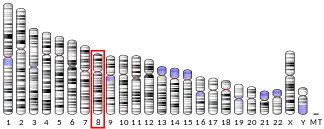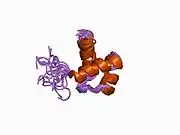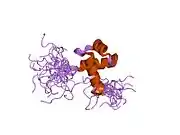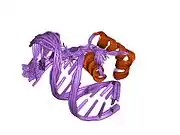Telomeric repeat-binding factor 1
Telomeric repeat-binding factor 1 is a protein that in humans is encoded by the TERF1 gene.[5][6]
Gene
The human TERF1 gene is located in the chromosome 8 at 73,921,097-73,960,357 bp. Two transcripts of this gene are alternatively spliced products.[6] The TERF1 gene is also known as TRF, PIN2 (Proteinase Inhibitor 2), TRF1, t-TRF1 and h-TRF1-AS.[7]
Protein
The protein structure contains a C-terminal Myb motif, a dimerization domain (TERF homology) near its N-terminus and an acidic N-terminus.
Subcellular distribution
The cellular distribution of this DNA binding protein features the nucleoplasm, chromosomes, a telomeric region, a nuclear telomere cap complex, the cytoplasm, the spindle, the nucleus and a nucleolus and a nuclear chromosome.
Function
TERF 1 gene encodes a telomere specific protein which is a component of the telomere's shelterin nucleoprotein complex. This protein is present at telomeres throughout the cell cycle and functions as an inhibitor of telomerase, acting in cis to limit the elongation of individual chromosome ends. It is known to protect telomeres in mammals from DNA mechanisms that are used for repair purposes and at the same time regulate the activity carried out by telomerase. The telomeric repeat binding factor 1 protein is present at telomeres, where the cells aging aspect is monitored, throughout the typical cell cycle process.[7] The progressive loss of the telomeric ends of chromosomes is an important mechanism in the timing of human cellular aging. Telomeric Repeat Factor 1 (TRF1) is a protein that binds at telomere ends.
The protein has the ultimate use of functioning as an inhibitor of telomerase, a protein enzyme that assists in the elongation of chromosomes by the addition of sequences of TTAGGG to the end of the chromosomes. The protein acts as cis-regulatory elements in the process of limiting the ends of individual chromosomes from elongating as facilitated by telomerase and the TTAGGG sequences. The structure of the protein consists of a dimerization domain close to its amino terminus, a carboxyl terminal tail, which is the free carboxyl group that terminates the end of a protein chain and an acidic amino terminus, which is the free amine group that terminates the start of a protein.
Biological processes
The protein is also actively involved in biological processes such as those relating to drug absorption as well as the negative regulation of the maintenance of telomere through the process of semi-conservative replication, similar to that of cis. In addition, according to Kaplan and Christopher, the protein is also involved in the biological processes of positive regulation of the polymerization of the microtubule and negative control of the process of DNA replication.[8] This protein is also useful in the biological process of mitosis and the positive regulation of mitosis. It positively regulates the mitotic cell cycle. The protein encoded by the TERF 1 gene is also involved in the biological process of cell division and the negative regulation of the maintenance of telomere facilitated by the enzyme telomerase.
Other than functioning as an inhibitor of the enzyme telomerase in the process of elongation of the ends of chromosomes, the protein has other functions. These functions include the binding of the protein, facilitation in the activity of protein homodimerization, the binding of DNA and facilitation in the activity of protein heterodimerization as well as the binding of the microtubule. Additionally, the protein has a molecular function of binding telomeric DNA and the double-stranded telomeric DNA. The telomeric repeat-binding factor 1 protein is also used in the binding of chromatin and the whole activity of bending of the DNA.[7]
Clinical significance
TERF1 protein levels correlates with telomere length in colorectal cancer. Telomeres protect the chromosome from degradation by nucleases and end-to-end fusion. The progressive loss of the telomeric ends of chromosomes is an important mechanism in the timing of human cellular aging. Telomeric Repeat Factor 1 (TRF1) is a protein that binds at telomere ends. To measure the concentrations of TRF1 and the relationships among telomere length, telomerase activity, and TRF1 levels in tumor and normal colorectal mucosa, from normal and tumoral samples of patients who underwent surgery for colorectal cancer we analyzed TRF1 protein concentration, and telomerase activity were analysed. As result high levels of TRF1 were observed in 68.7% of tumor samples, while the majority of normal samples showed negative or weak TRF1 concentrations. Among the tumor samples, telomere length was significantly associated with TRF1 protein levels. In conclusion a relationship exists between telomere length and TRF1 abundance protein in tumor samples, which means that TRF1 is an important factor in the tumor progression and maybe a diagnostic factor.
Interactions
The TERF1 encoded protein has been shown to have interactions with the following; SALL1 (Sal-like1- Drosophila, a protein.), ABL (Abelson murine leukemia viral oncogene homolog, a protein), MAPRE2 (Microtubule-associated protein RP/EB, a protein), ATM (Ataxia telangiectasia mutated, a protein kinase), PINX1 (TERF1-interacting telomerase inhibitor 1), TINF2 (TERF1-interacting telomerase nuclear factor), TNKS2 (Tankyrase, an enzyme) and NME1 (nucleoside diphosphate kinase).In conclusion, as mentioned above, the telomeric repeat-binding factor 1 protein has most of its functions related to the binding of components and regulation of processes.[8]
TERF1 has been shown to interact with:
References
- GRCh38: Ensembl release 89: ENSG00000147601 - Ensembl, May 2017
- GRCm38: Ensembl release 89: ENSMUSG00000025925 - Ensembl, May 2017
- "Human PubMed Reference:". National Center for Biotechnology Information, U.S. National Library of Medicine.
- "Mouse PubMed Reference:". National Center for Biotechnology Information, U.S. National Library of Medicine.
- Shen M, Haggblom C, Vogt M, Hunter T, Lu KP (January 1998). "Characterization and cell cycle regulation of the related human telomeric proteins Pin2 and TRF1 suggest a role in mitosis". Proc. Natl. Acad. Sci. U.S.A. 94 (25): 13618–23. doi:10.1073/pnas.94.25.13618. PMC 28355. PMID 9391075.
- "Entrez Gene: TERF1 telomeric repeat binding factor (NIMA-interacting) 1".
- Garton M, Laughton C (Aug 2013). "A comprehensive model for the recognition of human telomeres by TRF1". Journal of Molecular Biology. 425 (16): 2910–21. doi:10.1016/j.jmb.2013.05.005. PMC 3776228. PMID 23702294.
- Kaplan CW, Kitts CL (Jul 2003). "Variation between observed and true Terminal Restriction Fragment length is dependent on true TRF length and purine content". Journal of Microbiological Methods. 54 (1): 121–5. doi:10.1016/s0167-7012(03)00003-4. PMID 12732430.
- Kishi S, Zhou XZ, Ziv Y, Khoo C, Hill DE, Shiloh Y, Lu KP (August 2001). "Telomeric protein Pin2/TRF1 as an important ATM target in response to double strand DNA breaks". J. Biol. Chem. 276 (31): 29282–91. doi:10.1074/jbc.M011534200. PMID 11375976.
- Nakamura M, Zhou XZ, Kishi S, Lu KP (March 2002). "Involvement of the telomeric protein Pin2/TRF1 in the regulation of the mitotic spindle". FEBS Lett. 514 (2–3): 193–8. doi:10.1016/s0014-5793(02)02363-3. PMID 11943150. S2CID 2579290.
- Nosaka K, Kawahara M, Masuda M, Satomi Y, Nishino H (February 1998). "Association of nucleoside diphosphate kinase nm23-H2 with human telomeres". Biochem. Biophys. Res. Commun. 243 (2): 342–8. doi:10.1006/bbrc.1997.8097. PMID 9480811.
- Zhou XZ, Lu KP (November 2001). "The Pin2/TRF1-interacting protein PinX1 is a potent telomerase inhibitor". Cell. 107 (3): 347–59. doi:10.1016/s0092-8674(01)00538-4. PMID 11701125. S2CID 6822193.
- Netzer C, Rieger L, Brero A, Zhang CD, Hinzke M, Kohlhase J, Bohlander SK (Dec 2001). "SALL1, the gene mutated in Townes-Brocks syndrome, encodes a transcriptional repressor which interacts with TRF1/PIN2 and localizes to pericentromeric heterochromatin". Hum. Mol. Genet. 10 (26): 3017–24. doi:10.1093/hmg/10.26.3017. PMID 11751684.
- Liu D, Safari A, O'Connor MS, Chan DW, Laegeler A, Qin J, Songyang Z (July 2004). "PTOP interacts with POT1 and regulates its localization to telomeres". Nat. Cell Biol. 6 (7): 673–80. doi:10.1038/ncb1142. PMID 15181449. S2CID 11543383.
- Stelzl U, Worm U, Lalowski M, Haenig C, Brembeck FH, Goehler H, Stroedicke M, Zenkner M, Schoenherr A, Koeppen S, Timm J, Mintzlaff S, Abraham C, Bock N, Kietzmann S, Goedde A, Toksöz E, Droege A, Krobitsch S, Korn B, Birchmeier W, Lehrach H, Wanker EE (September 2005). "A human protein-protein interaction network: a resource for annotating the proteome". Cell. 122 (6): 957–68. doi:10.1016/j.cell.2005.08.029. hdl:11858/00-001M-0000-0010-8592-0. PMID 16169070. S2CID 8235923.
- Kim SH, Kaminker P, Campisi J (Dec 1999). "TIN2, a new regulator of telomere length in human cells". Nat. Genet. 23 (4): 405–12. doi:10.1038/70508. PMC 4940194. PMID 10581025.
- Cook BD, Dynek JN, Chang W, Shostak G, Smith S (January 2002). "Role for the related poly(ADP-Ribose) polymerases tankyrase 1 and 2 at human telomeres". Mol. Cell. Biol. 22 (1): 332–42. doi:10.1128/mcb.22.1.332-342.2002. PMC 134233. PMID 11739745.
- Chi NW, Lodish HF (Dec 2000). "Tankyrase is a golgi-associated mitogen-activated protein kinase substrate that interacts with IRAP in GLUT4 vesicles". J. Biol. Chem. 275 (49): 38437–44. doi:10.1074/jbc.M007635200. PMID 10988299.
- Sbodio JI, Lodish HF, Chi NW (February 2002). "Tankyrase-2 oligomerizes with tankyrase-1 and binds to both TRF1 (telomere-repeat-binding factor 1) and IRAP (insulin-responsive aminopeptidase)". Biochem. J. 361 (Pt 3): 451–9. doi:10.1042/0264-6021:3610451. PMC 1222327. PMID 11802774.
- Seimiya H, Smith S (April 2002). "The telomeric poly(ADP-ribose) polymerase, tankyrase 1, contains multiple binding sites for telomeric repeat binding factor 1 (TRF1) and a novel acceptor, 182-kDa tankyrase-binding protein (TAB182)". J. Biol. Chem. 277 (16): 14116–26. doi:10.1074/jbc.M112266200. PMID 11854288.
- Sbodio JI, Chi NW (August 2002). "Identification of a tankyrase-binding motif shared by IRAP, TAB182, and human TRF1 but not mouse TRF1. NuMA contains this RXXPDG motif and is a novel tankyrase partner". J. Biol. Chem. 277 (35): 31887–92. doi:10.1074/jbc.M203916200. PMID 12080061.
- Smith S, Giriat I, Schmitt A, de Lange T (November 1998). "Tankyrase, a poly(ADP-ribose) polymerase at human telomeres". Science. 282 (5393): 1484–7. CiteSeerX 10.1.1.466.9024. doi:10.1126/science.282.5393.1484. PMID 9822378.
Further reading
- Zhong Z, Shiue L, Kaplan S, de Lange T (1992). "A mammalian factor that binds telomeric TTAGGG repeats in vitro". Mol. Cell. Biol. 12 (11): 4834–43. doi:10.1128/mcb.12.11.4834. PMC 360416. PMID 1406665.
- Chong L, van Steensel B, Broccoli D, Erdjument-Bromage H, Hanish J, Tempst P, de Lange T (1995). "A human telomeric protein". Science. 270 (5242): 1663–7. Bibcode:1995Sci...270.1663C. doi:10.1126/science.270.5242.1663. PMID 7502076. S2CID 25439525.
- Lu KP, Hanes SD, Hunter T (1996). "A human peptidyl-prolyl isomerase essential for regulation of mitosis". Nature. 380 (6574): 544–7. Bibcode:1996Natur.380..544P. doi:10.1038/380544a0. PMID 8606777. S2CID 4258406.
- Bilaud T, Koering CE, Binet-Brasselet E, Ancelin K, Pollice A, Gasser SM, Gilson E (1996). "The telobox, a Myb-related telomeric DNA binding motif found in proteins from yeast, plants and human". Nucleic Acids Res. 24 (7): 1294–303. doi:10.1093/nar/24.7.1294. PMC 145771. PMID 8614633.
- Broccoli D, Chong L, Oelmann S, Fernald AA, Marziliano N, van Steensel B, Kipling D, Le Beau MM, de Lange T (1997). "Comparison of the human and mouse genes encoding the telomeric protein, TRF1: chromosomal localization, expression and conserved protein domains". Hum. Mol. Genet. 6 (1): 69–76. doi:10.1093/hmg/6.1.69. PMID 9002672.
- Bianchi A, Smith S, Chong L, Elias P, de Lange T (1997). "TRF1 is a dimer and bends telomeric DNA". EMBO J. 16 (7): 1785–94. doi:10.1093/emboj/16.7.1785. PMC 1169781. PMID 9130722.
- Broccoli D, Smogorzewska A, Chong L, de Lange T (1997). "Human telomeres contain two distinct Myb-related proteins, TRF1 and TRF2". Nat. Genet. 17 (2): 231–5. doi:10.1038/ng1097-231. PMID 9326950. S2CID 41204064.
- Nosaka K, Kawahara M, Masuda M, Satomi Y, Nishino H (1998). "Association of nucleoside diphosphate kinase nm23-H2 with human telomeres". Biochem. Biophys. Res. Commun. 243 (2): 342–8. doi:10.1006/bbrc.1997.8097. PMID 9480811.
- Nishikawa T, Nagadoi A, Yoshimura S, Aimoto S, Nishimura Y (1998). "Solution structure of the DNA-binding domain of human telomeric protein, hTRF1". Structure. 6 (8): 1057–65. doi:10.1016/S0969-2126(98)00106-3. PMID 9739097.
- Smith S, Giriat I, Schmitt A, de Lange T (1998). "Tankyrase, a poly(ADP-ribose) polymerase at human telomeres". Science. 282 (5393): 1484–7. CiteSeerX 10.1.1.466.9024. doi:10.1126/science.282.5393.1484. PMID 9822378.
- Kim SH, Kaminker P, Campisi J (1999). "TIN2, a new regulator of telomere length in human cells". Nat. Genet. 23 (4): 405–12. doi:10.1038/70508. PMC 4940194. PMID 10581025.
- Smogorzewska A, van Steensel B, Bianchi A, Oelmann S, Schaefer MR, Schnapp G, de Lange T (2000). "Control of human telomere length by TRF1 and TRF2". Mol. Cell. Biol. 20 (5): 1659–68. doi:10.1128/MCB.20.5.1659-1668.2000. PMC 85349. PMID 10669743.
- Wu G, Lee WH, Chen PL (2000). "NBS1 and TRF1 colocalize at promyelocytic leukemia bodies during late S/G2 phases in immortalized telomerase-negative cells. Implication of NBS1 in alternative lengthening of telomeres". J. Biol. Chem. 275 (39): 30618–22. doi:10.1074/jbc.C000390200. PMID 10913111.
- Chi NW, Lodish HF (2000). "Tankyrase is a golgi-associated mitogen-activated protein kinase substrate that interacts with IRAP in GLUT4 vesicles". J. Biol. Chem. 275 (49): 38437–44. doi:10.1074/jbc.M007635200. PMID 10988299.
- Kishi S, Wulf G, Nakamura M, Lu KP (2001). "Telomeric protein Pin2/TRF1 induces mitotic entry and apoptosis in cells with short telomeres and is down-regulated in human breast tumors". Oncogene. 20 (12): 1497–508. doi:10.1038/sj.onc.1204229. PMID 11313893.
- Kishi S, Zhou XZ, Ziv Y, Khoo C, Hill DE, Shiloh Y, Lu KP (2001). "Telomeric protein Pin2/TRF1 as an important ATM target in response to double strand DNA breaks". J. Biol. Chem. 276 (31): 29282–91. doi:10.1074/jbc.M011534200. PMID 11375976.
- Fairall L, Chapman L, Moss H, de Lange T, Rhodes D (2001). "Structure of the TRFH dimerization domain of the human telomeric proteins TRF1 and TRF2". Mol. Cell. 8 (2): 351–61. doi:10.1016/S1097-2765(01)00321-5. PMID 11545737.
- Zhou XZ, Lu KP (2001). "The Pin2/TRF1-interacting protein PinX1 is a potent telomerase inhibitor". Cell. 107 (3): 347–59. doi:10.1016/S0092-8674(01)00538-4. PMID 11701125. S2CID 6822193.
- Nishikawa T, Okamura H, Nagadoi A, König P, Rhodes D, Nishimura Y (2001). "Solution structure of a telomeric DNA complex of human TRF1". Structure. 9 (12): 1237–51. doi:10.1016/S0969-2126(01)00688-8. PMID 11738049.









